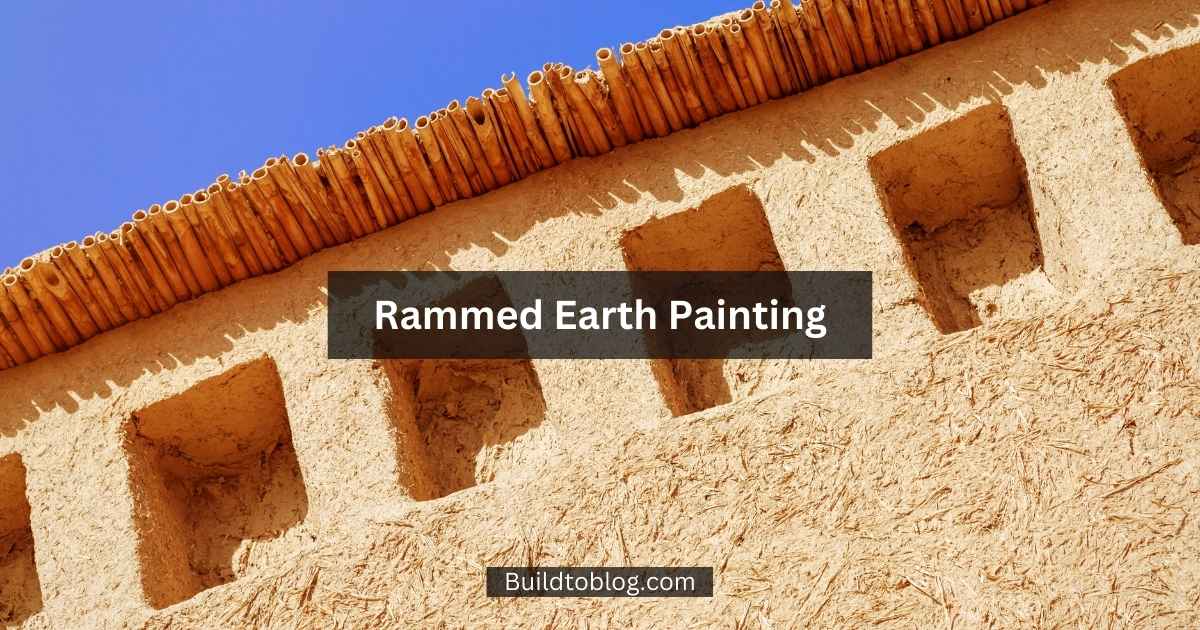Rammed earth painting is a blend of tradition and modernity, adding artistic charm and functional benefits to ancient earthen walls. This process allows homeowners, architects, and artists to combine sustainability with aesthetics, enhancing the natural beauty of rammed earth while offering protection from the elements. With the right approach, rammed earth painting can transform a humble earth wall into a statement of color and texture.
In this article, we’ll explore everything you need to know about rammed earth painting, from preparation techniques to the types of paints that work best for this unique surface. Whether you’re looking to restore an old wall or personalize a new one, these insights will help you create a long-lasting and beautiful finish.
What Is Rammed Earth, and Why Paint It?
Rammed earth is an eco-friendly building material created by compressing layers of soil, sand, and sometimes small gravel into a dense, stone-like structure. Known for its durability, thermal mass, and natural aesthetic, rammed earth has been used for thousands of years across cultures. Painting rammed earth walls offers several benefits:
Enhanced Aesthetic Appeal: Painting provides color and vibrancy, which can either blend structures into natural surroundings or help them stand out as architectural highlights.
Increased Durability: Certain paints add a layer of protection against water, UV rays, and surface wear.
Personalization: Rammed earth painting allows you to add unique, artistic touches to otherwise earthy surfaces.
Choosing the Right Paint for Rammed Earth Walls
Not every paint type is suitable for rammed earth walls, as the material’s porosity requires breathable finishes that can withstand the elements. Below are some ideal types:
Lime Wash: This traditional, natural paint is breathable and ideal for rammed earth surfaces. It gives an earthy, matte finish that complements the wall’s natural tones.
Silicate Paint: Silicate paints are mineral-based and bond chemically with the surface, creating a durable, water-resistant layer suitable for outdoor walls.
Clay Paint: Made from natural clay, this eco-friendly option is especially popular for indoor walls, preserving the natural aesthetic and breathability.
Acrylic Paint: While not as breathable, some low-VOC acrylic paints can be used on rammed earth if a breathable primer is applied first.
Preparing a Rammed Earth Wall for Painting
Proper preparation is essential for ensuring that the paint adheres to the wall and lasts over time. Here’s a step-by-step guide:
Clean the Surface: Use a soft brush or cloth to remove dust and loose particles. A clean surface helps the paint bond better.
Dampen the Wall: Lightly mist the wall with water to reduce the absorbency and allow for even paint application.
Prime the Wall (Optional): Depending on the paint, a breathable primer can be applied to improve adhesion. Be sure to select a primer compatible with the paint you plan to use.
Techniques for Painting Rammed Earth Walls
Different techniques can achieve varied results depending on the look you want. Here are some popular methods:
Brush Painting: Use a wide, soft-bristled brush for even coverage. Brush painting offers better control for adding texture.
Spray Painting: For larger surfaces, a spray gun provides a fast, even application, particularly helpful for outdoor or high walls.
Sponge or Texture Techniques: To add a unique, rustic finish, apply paint using a sponge or textured brush. This technique enhances the natural irregularities of the wall.
Tips for Creating Artistic Effects on Rammed Earth
Rammed earth painting provides a unique canvas for artistic effects, allowing homeowners to blend architecture with creative design:
Ombre Gradient: Create a gradient from dark to light by layering colors from the base upwards. This effect can make walls appear taller or create a calming ambiance.
Stenciling: Stencils can be used to add patterns or designs, offering an easy way to incorporate symbols or motifs that reflect personal style.
Layering Colors: Experiment with layering multiple colors to achieve a rich, dimensional effect that brings depth to the wall.
Drying and Curing: What to Expect
Due to the porous nature of rammed earth, drying times can be longer than with other surfaces. Here’s what to keep in mind:
Patience Is Key: Allow each coat to dry fully before applying the next to avoid peeling or cracking.
Thin Coats Work Best: Avoid thick coats of paint, which may not adhere well. Applying multiple thin coats helps prevent oversaturation and ensures even drying.
Maintaining Painted Rammed Earth Walls
Rammed earth walls require minimal maintenance, but following these tips can help the paint last:
Dusting: Use a soft, dry cloth to clean the walls as needed. Avoid using water or harsh cleaners, as they can damage the paint.
Touch-ups: Minor chips or scuffs can be touched up with matching paint, ensuring that the wall remains vibrant and intact.
Periodic Repainting: Depending on exposure, consider a fresh coat every few years to maintain color and protection.
Challenges to Consider with Rammed Earth Painting
Painting on rammed earth isn’t without its challenges. Understanding these can help you avoid common pitfalls:
Moisture Management: Earth walls are prone to absorb moisture, which can affect paint adhesion and durability. Choose breathable paint and monitor the wall for signs of dampness.
Temperature Variability: High temperatures can cause paint to dry too quickly, leading to cracks, while low temperatures may delay drying. Always aim to paint in mild, stable weather.
Surface Irregularities: Rammed earth has a natural, uneven texture. Embrace these irregularities, as they add character to the finished wall.
Benefits of Rammed Earth Painting
In addition to aesthetic enhancement, painting a rammed earth wall offers practical advantages:
Eco-Friendly Option: By using natural paints like lime wash or clay paint, you align with the sustainability of the rammed earth structure.
Increased Wall Protection: Paint can shield the wall from environmental wear and tear, helping it last longer.
Improved Indoor Comfort: Breathable paints contribute to the natural thermal regulation properties of rammed earth, promoting an energy-efficient space.
Conclusion
Rammed earth painting combines tradition with innovation, transforming a sturdy, earthy wall into a beautiful, personalized feature of a home or structure. With proper preparation, paint selection, and techniques, a rammed earth wall can become a timeless piece of art that honors the beauty of nature and sustainability. Whether it’s through a bold, vibrant coat or a subtle, earth-toned finish, painting brings a unique layer of life and personality to these ancient structures.
FAQs
Is any type of paint suitable for rammed earth?
A: No, only breathable paints like lime wash, silicate, and clay paints are recommended to preserve the wall’s durability and appearance.
How long will paint last on a rammed earth wall?
A: Paint can last several years, but touch-ups or a new coat may be needed every few years depending on exposure to sunlight and moisture.
Can I paint a rammed earth wall myself?
A: Yes! With the right preparation and materials, DIY painting of rammed earth walls is possible, although large projects may benefit from professional help.
Do I need to seal a painted rammed earth wall?
A: A breathable sealant can help protect outdoor walls from moisture, but is generally optional for interior walls.
Does painting affect the thermal properties of a rammed earth wall?
A: Breathable, natural paints like clay and lime wash support thermal regulation, while non-breathable paints may slightly reduce these benefits.





